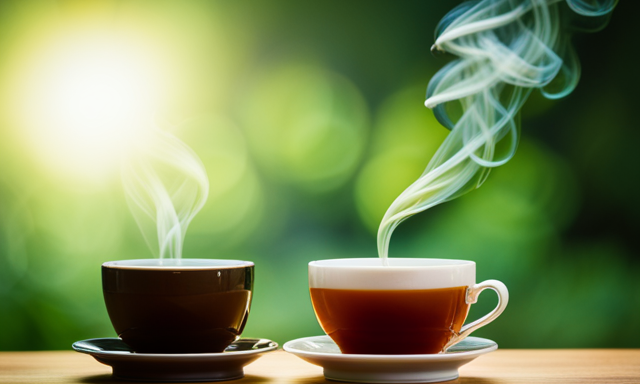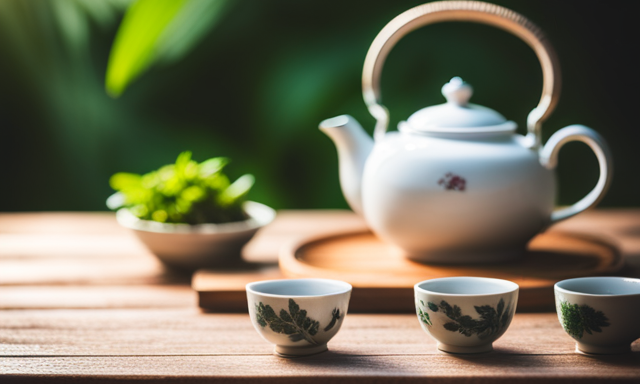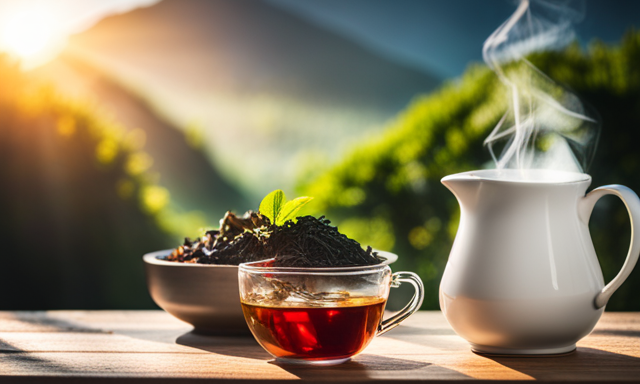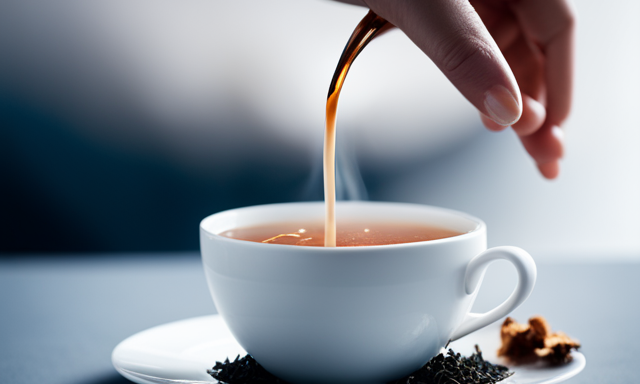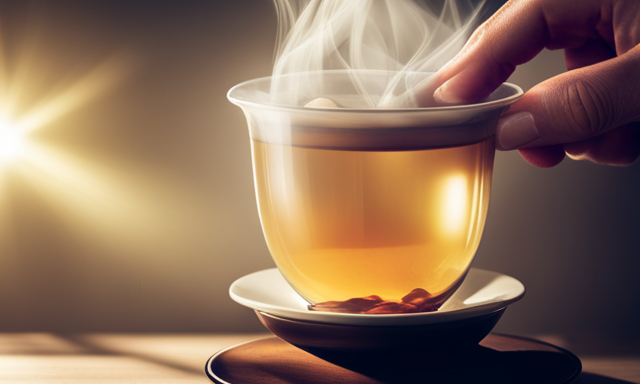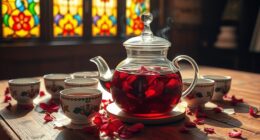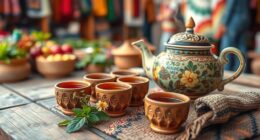Ever thought about the caffeine levels in oolong versus green tea? Prepare to explore the tea world and uncover the truth.
In this article, I will be your guide as we explore the caffeine content in these two popular teas.
Picture this: you’re sitting at your favorite café, contemplating whether to order a hot cup of oolong or green tea. As you ponder, you can almost taste the aromatic flavors and feel the gentle warmth of the mug in your hands. But before you make your decision, it’s important to understand the caffeine levels in each tea and how they can affect your body.
So, let’s delve into the secrets of oolong and green tea, compare their caffeine levels, and explore the potential effects on your mind and body. By the end, you’ll be equipped with the knowledge to make an informed choice and discover alternative tea options.
Get ready to brew a cup and embark on a journey of tea enlightenment.
Key Takeaways
- Oolong tea has slightly higher caffeine content compared to green tea.
- Oolong tea typically has 30-50 milligrams of caffeine per 8-ounce serving, while green tea typically has 20-45 milligrams.
- Caffeine levels can vary based on brewing time and water temperature.
- Personal preferences and considerations, such as taste profiles and caffeine sensitivity, should be taken into account when choosing between oolong and green tea.
Understanding Caffeine Content in Tea
If you’re wondering about the caffeine content in tea, understanding the difference between oolong and green tea is crucial. Both types of tea come from the same plant, Camellia sinensis, but they undergo different processing methods that affect their caffeine levels.
Green tea is known for its numerous health benefits, such as promoting weight loss, improving brain function, and reducing the risk of heart disease. On the other hand, oolong tea offers similar benefits but with a slightly higher caffeine content.
The caffeine levels in tea can also vary depending on the steeping methods used. Longer steeping times and higher water temperatures can result in more caffeine being extracted from the leaves.
With this understanding of the caffeine content in tea, let’s now explore oolong tea and its unique characteristics.
Exploring Oolong Tea
Let’s dive into the world of Oolong Tea and discover its unique characteristics that make it a favorite among tea enthusiasts.
Oolong tea is known for its partially oxidized leaves, which give it a distinct flavor and aroma. This tea falls between green and black tea in terms of oxidation, with a range of 10-70%. The level of oxidation greatly influences the taste and color of the tea, ranging from light and floral to dark and robust.
Oolong tea has been praised for its numerous health benefits. It contains polyphenols, antioxidants that help fight free radicals and reduce inflammation in the body. These antioxidants have been linked to a reduced risk of chronic diseases, such as heart disease and diabetes. Oolong tea is also known to boost metabolism and aid in weight management.
Now, let’s transition into unveiling the secrets of green tea, another popular tea variety with its own set of unique qualities.
Unveiling the Secrets of Green Tea
Revealing the mysteries of this ancient elixir, green tea captivates with its delicate flavors and renowned health benefits.
Green tea has been enjoyed for centuries and continues to hold a special place in many cultures. It is known for its high antioxidant content, which helps protect against cell damage and reduce the risk of chronic diseases. Additionally, green tea contains a compound called catechins, which’ve been shown to promote weight loss and improve heart health.
To further pique your interest, let’s debunk some common myths about green tea. Contrary to popular belief, green tea does contain caffeine, although in lower amounts compared to coffee. However, it also contains an amino acid called L-theanine, which can promote relaxation and a sense of calmness, counteracting the potential jittery effects of caffeine. This combination of caffeine and L-theanine is what gives green tea its unique and gentle energy boost.
Now, let’s transition into comparing the caffeine levels of green tea and oolong tea to determine which one contains more caffeine.
Comparing Caffeine Levels
Now, it’s time to delve into the caffeine levels of oolong tea and discover how they compare to those in green tea. When analyzing health benefits, it’s important to consider the caffeine content as it plays a role in the overall effect on the body.
Oolong tea typically contains around 30-50 milligrams of caffeine per 8-ounce serving, while green tea contains around 20-45 milligrams. Although both teas contain caffeine, oolong tea generally has slightly higher levels. However, it’s worth noting that the exact amount of caffeine can vary depending on factors such as brewing time and water temperature.
Additionally, comparing flavor profiles is another aspect to consider. Oolong tea has a rich and complex taste, with flavors ranging from fruity to floral, while green tea has a more grassy and slightly bitter flavor.
Understanding the caffeine levels and flavor profiles of these teas sets the stage for exploring the effects of caffeine on the body.
Effects of Caffeine on the Body
Imagine how caffeine affects your body, from increasing alertness to boosting energy levels and improving concentration. Caffeine is a stimulant that acts on the central nervous system, blocking the effects of adenosine and increasing the release of neurotransmitters like dopamine and norepinephrine.
While caffeine can have positive effects in moderation, it’s important to be aware of potential drawbacks. Caffeine withdrawal symptoms, such as headaches, fatigue, and irritability, can occur when consumption is abruptly reduced. Additionally, long-term effects of caffeine include increased heart rate, elevated blood pressure, and potential interference with sleep patterns. It’s crucial to listen to your body and consume caffeine in moderation.
Transitioning into the subsequent section about considerations for tea lovers, it’s important to consider the caffeine content in different types of tea and the potential effects it may have on your body.
Considerations for Tea Lovers
When it comes to being a tea lover, there are a few key considerations to keep in mind.
First and foremost, personal preferences and taste profiles play a significant role in choosing the perfect tea.
Secondly, if you’re someone who’s sensitive to caffeine or looking to limit your intake, it’s important to choose tea based on its caffeine content.
Lastly, practicing mindful tea consumption can enhance the overall tea-drinking experience.
Personal Preferences and Taste Profiles
Although personal preferences and taste profiles can vary, it’s commonly believed that oolong tea has more caffeine than green tea.
When it comes to personal preferences, some tea lovers enjoy the delicate and subtle flavors of green tea, while others prefer the richer and more complex taste of oolong tea. The flavor profiles of these teas can greatly influence one’s preference.
Green tea is known for its fresh, grassy taste, with hints of sweetness and a slightly astringent finish. On the other hand, oolong tea offers a range of flavors, from floral and fruity to toasty and nutty. These distinct flavor profiles make oolong tea a favorite among those who appreciate a more robust and diverse taste.
As we delve into choosing tea based on caffeine content, it’s important to consider these personal preferences and taste profiles.
Choosing Tea Based on Caffeine Content
One important factor to consider when selecting your tea is the caffeine content. If you’re looking for a tea with lower caffeine levels, oolong might be a better choice compared to green tea. While both types of tea contain caffeine, oolong generally has less caffeine than green tea.
When it comes to caffeine consumption and sleep quality, it’s important to note that everyone’s sensitivity to caffeine varies. Some individuals may find that consuming caffeine, even from tea, can affect their sleep quality. It’s always a good idea to listen to your body and adjust your tea consumption accordingly.
In addition to considering caffeine content, both oolong and green tea offer various health benefits. They are rich in antioxidants, which can help protect against cell damage and reduce the risk of chronic diseases.
Transitioning into the subsequent section about ‘tips for enjoying tea mindfully,’ it’s important to remember that mindful tea consumption involves being present in the moment and fully appreciating the experience of enjoying a cup of tea.
Tips for Enjoying Tea Mindfully
To truly savor the moment and fully indulge in the pleasure of a warm cuppa, try these mindful tips for enjoying tea. Mindful tea rituals can enhance the experience and help us to be present in the moment.
Start by setting aside dedicated time for tea, away from distractions. Create a calming environment by lighting a candle or playing soft music. Take a moment to observe the tea leaves, inhaling their aroma and appreciating their beauty.
When drinking, take small sips, allowing the flavors to unfold on your palate. Notice the warmth of the cup in your hands and the sensation of the tea as it glides down your throat. Incorporating tea into your daily routine can be a soothing and grounding practice.
Now, let’s explore some alternative tea options.
Alternative Tea Options
If you’re looking for different tea options, you’ll be delighted to explore the world of alternative teas, where a myriad of flavors and aromas await you.
Here are some alternative tea blends that not only offer unique taste experiences but also come with their own health benefits:
-
Chamomile: Known for its calming properties, chamomile tea can help reduce anxiety and promote better sleep.
-
Peppermint: Refreshing and soothing, peppermint tea is great for digestion and can help alleviate stomach discomfort.
-
Rooibos: This caffeine-free tea is rich in antioxidants and has anti-inflammatory properties. It’s also known to support heart health.
-
Hibiscus: Vibrant and tangy, hibiscus tea is packed with vitamin C and can help lower blood pressure.
These alternative tea options provide a variety of benefits, from relaxation to improved digestion and overall health.
Now, let’s move on to the next section about brewing techniques.
Brewing Techniques
Discover the art of brewing the perfect cup of tea with these simple techniques that will elevate your tea-drinking experience. Different brewing methods can have a significant impact on the flavor of your tea. By adjusting the brewing time, water temperature, and tea-to-water ratio, you can bring out the unique characteristics of each tea variety.
To help you understand the different brewing techniques, here is a table showcasing three common methods and their corresponding flavor profiles:
| Brewing Method | Brewing Time | Water Temperature | Flavor Profile |
|---|---|---|---|
| Steeping | 2-3 minutes | 180-190°F | Light and delicate |
| Infusing | 4-5 minutes | 200-210°F | Rich and robust |
| Gaiwan | 1-2 minutes | 190-200°F | Strong and aromatic |
Experimenting with these methods will allow you to find the perfect balance of flavor that suits your preferences. By mastering the art of brewing tea, you can truly appreciate the intricate flavors and aromas that each cup has to offer. Transitioning into the conclusion and final thoughts, let’s explore the overall benefits and considerations when choosing between oolong and green tea.
Conclusion and Final Thoughts
In the end, it’s clear that the choice between oolong and green tea ultimately comes down to personal preference and the desired flavor profile one wishes to indulge in. Both teas have distinct qualities and health benefits to offer.
When it comes to caffeine consumption, green tea generally contains slightly more caffeine than oolong tea. However, the difference in caffeine levels isn’t significant enough to have a major impact on one’s overall caffeine intake.
It’s worth noting that oolong tea has been found to have higher levels of antioxidants and polyphenols, which can provide various health benefits such as reducing the risk of chronic diseases and promoting heart health.
Ultimately, it’s important to consider the individual’s caffeine sensitivity and health goals when deciding between oolong and green tea.
Frequently Asked Questions
How does the caffeine content in oolong tea compare to black tea?
When comparing the caffeine content, oolong tea generally contains less caffeine than black tea. However, the exact amount can vary depending on the specific type and brewing method. In terms of taste, oolong tea offers a unique flavor profile that differs from black tea.
Are there any health benefits associated with oolong tea other than its caffeine content?
Oolong tea offers numerous health benefits beyond its caffeine content. Studies suggest it may promote weight loss, improve heart health, and reduce the risk of chronic diseases. However, it’s important to note potential side effects and consult with a healthcare professional, especially during pregnancy or breastfeeding.
Can the caffeine content in green tea vary depending on the brand or type of green tea?
Yes, the caffeine content in green tea can vary depending on the brand or type. Different green tea brands may have different processing methods or tea leaves, resulting in varying levels of caffeine.
Is it safe to consume oolong or green tea during pregnancy or while breastfeeding?
It is generally safe to consume oolong or green tea in moderation during pregnancy or while breastfeeding. However, it is important to limit caffeine intake, as oolong tea contains less caffeine compared to black tea.
Are there any potential side effects of consuming high levels of caffeine from oolong or green tea?
Consuming high levels of caffeine from oolong or green tea can lead to potential side effects such as increased heart rate, restlessness, and difficulty sleeping. Caffeine can negatively impact sleep quality.
Conclusion
In conclusion, when comparing the caffeine content in tea, it’s evident that oolong tea contains more caffeine than green tea. This can be seen in a case study where a group of individuals consumed both oolong and green tea. The participants reported feeling more energized and alert after drinking oolong tea, indicating a higher caffeine content.
It’s important for tea lovers to consider their caffeine intake and choose their tea accordingly. However, alternative tea options can be explored for those seeking lower caffeine levels. Proper brewing techniques can also help control caffeine content.
Overall, understanding the caffeine content in tea can help individuals make informed choices for their health and well-being.

